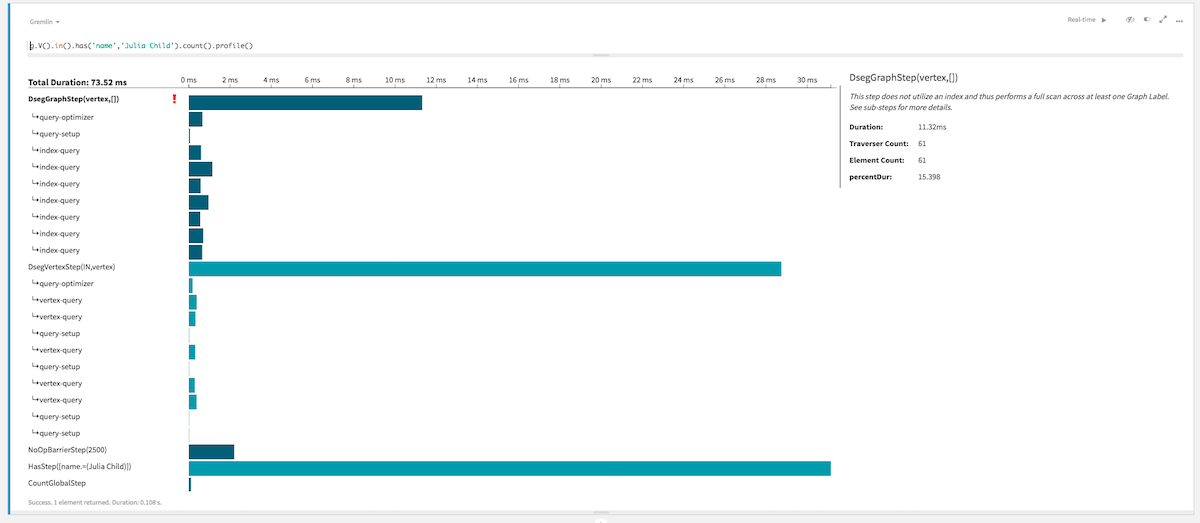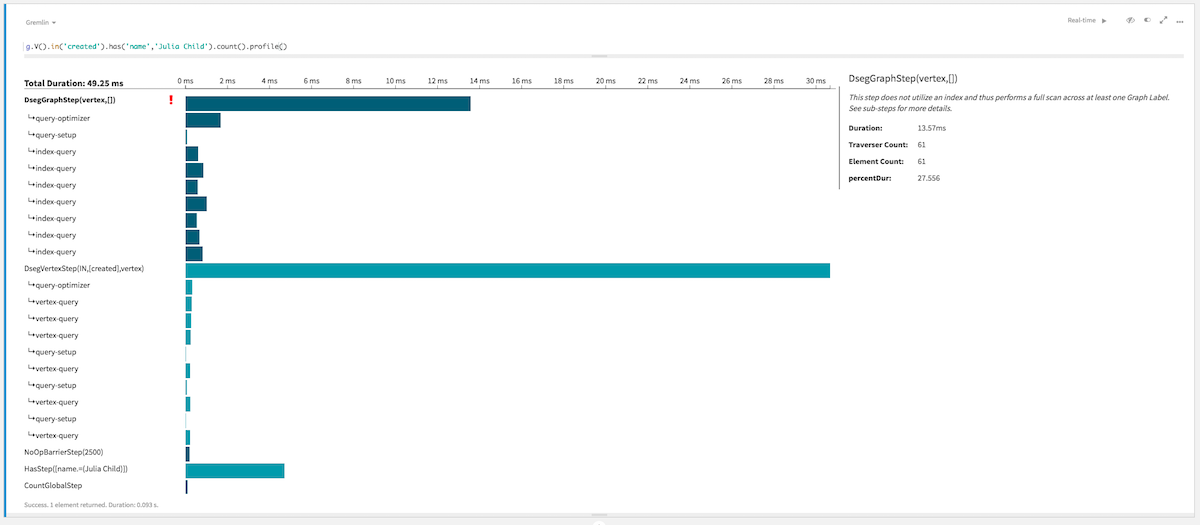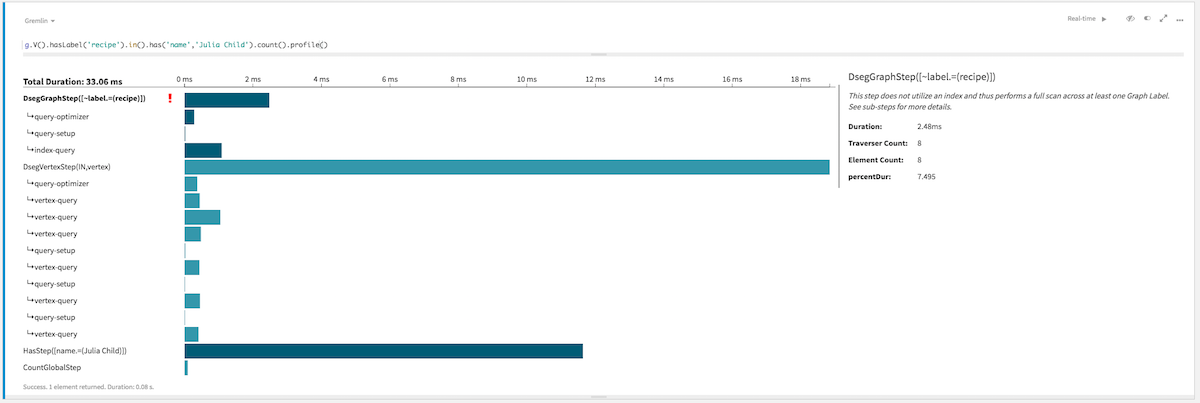OLTP and OLAP
OLTP and OLAP are different processing methods that DSE Graph uses to search graph databases.
Online transactional processing (OLTP) is characterized by a large number of short, online transactions for very fast query processing. OLTP is typically used for data entry and retrieval with transaction-oriented applications. Online analytical processing (OLAP) is typically used to perform multidimensional analysis of data, doing complex calculations on aggregated historical data.
OLTP applications require sub-second response times, whereas OLAP applications take much longer to finish queries. Graph databases are a random access data system. In these databases, OLAP traversals do a linear scan of all vertices in the graph. Conversely, OLTP traversals are localized to a particular subgraph of the global graph. OLTP traversals leverage indexes to "jump" in to a particular vertex in the graph before starting a scan on the subgraph.
OLTP queries
OLTP queries are best for questions that require access to a limited subset of the entire graph. OLTP queries use filters to limit the number of vertices that will be walked to find answers. DSE Graph co-locates vertices with their edges and adjacent neighbors. When a subgraph is specified in a traversal using indexes, the number of requests to disk are reduced to locate and write the requested subgraph to memory. Once in memory, the traversal performs a link walk from vertex to vertex along the edges.
OLAP queries
OLAP queries are best for questions that must access a significant portion of the data stored in a graph. Using the previous method to evaluate OLAP queries will not be efficient, so a different process is used. When OLAP queries are processed, the entire graph is interpreted as a sequence of star graphs, each composed of a single vertex, along with its properties, incident edges, and the edges' properties. The star graphs are linearly processed, jumping from one star graph to the next until all star graphs are processed and an aggregation of the discovered data is completed.
Principles for writing graph traversals
Understanding these underlying principles can lead to writing better graph traversals to
query the graph data. A simple example illustrates the differences. Using the food graph,
the query is How many recipes has Julia Child created?
g.V().in().has('name','Julia Child').count()
===>6This traversal completes the following processing:
- Looks at all vertices.
- Walks the incoming edges.
- Finds the adjacent vertices that have the property key of
nameand property value ofJulia Child. - Counts the number of vertices.
This graph traversal is a classic OLAP traversal, which must touch all vertices and does not use indexing. The count returned includes all vertices with edges to Julia Child, and not just the recipes, so as shown later, the count is incorrect and too high.
gremlin> g.V().in().has('name','Julia Child').count().profile()
==>Traversal Metrics
Step Count Traversers Time (ms) % Dur
=============================================================================================================
DsegGraphStep(vertex,[]) 61 61 28.932 18.71
query-optimizer 0.563
\_condition=((label = FridgeSensor | label = author | label = book | label = ingredient | label = meal |
label = recipe | label = reviewer) & (true))
query-setup 0.048
\_isFitted=true
\_isSorted=false
\_isScan=true
index-query 0.979
\_usesCache=false
\_statement=SELECT "city_id", "sensor_id" FROM "DSEQuickStart"."FridgeSensor_p" WHERE "~~vertex_exists" =
? LIMIT ? ALLOW FILTERING; with params (java.lang.Boolean) true, (java.lang.Integer) 50000
\_options=Options{consistency=Optional[ONE], serialConsistency=Optional.empty, fallbackConsistency=Option
al.empty, pagingState=null, pageSize=-1, user=Optional.empty, waitForSchemaAgreement=true, asyn
c=true}
index-query 0.862
\_usesCache=false
\_statement=SELECT "community_id", "member_id" FROM "DSEQuickStart"."author_p" WHERE "~~vertex_exists" =
? LIMIT ? ALLOW FILTERING; with params (java.lang.Boolean) true, (java.lang.Integer) 50000
\_options=Options{consistency=Optional[ONE], serialConsistency=Optional.empty, fallbackConsistency=Option
al.empty, pagingState=null, pageSize=-1, user=Optional.empty, waitForSchemaAgreement=true, asyn
c=true}
index-query 0.679
\_usesCache=false
\_statement=SELECT "community_id", "member_id" FROM "DSEQuickStart"."book_p" WHERE "~~vertex_exists" = ?
LIMIT ? ALLOW FILTERING; with params (java.lang.Boolean) true, (java.lang.Integer) 50000
\_options=Options{consistency=Optional[ONE], serialConsistency=Optional.empty, fallbackConsistency=Option
al.empty, pagingState=null, pageSize=-1, user=Optional.empty, waitForSchemaAgreement=true, asyn
c=true}
index-query 1.344
\_usesCache=false
\_statement=SELECT "community_id", "member_id" FROM "DSEQuickStart"."ingredient_p" WHERE "~~vertex_exists
" = ? LIMIT ? ALLOW FILTERING; with params (java.lang.Boolean) true, (java.lang.Integer) 5000
0
\_options=Options{consistency=Optional[ONE], serialConsistency=Optional.empty, fallbackConsistency=Option
al.empty, pagingState=null, pageSize=-1, user=Optional.empty, waitForSchemaAgreement=true, asyn
c=true}
index-query 1.053
\_usesCache=false
\_statement=SELECT "community_id", "member_id" FROM "DSEQuickStart"."meal_p" WHERE "~~vertex_exists" = ?
LIMIT ? ALLOW FILTERING; with params (java.lang.Boolean) true, (java.lang.Integer) 50000
\_options=Options{consistency=Optional[ONE], serialConsistency=Optional.empty, fallbackConsistency=Option
al.empty, pagingState=null, pageSize=-1, user=Optional.empty, waitForSchemaAgreement=true, asyn
c=true}
index-query 4.173
\_usesCache=false
\_statement=SELECT "community_id", "member_id" FROM "DSEQuickStart"."recipe_p" WHERE "~~vertex_exists" =
? LIMIT ? ALLOW FILTERING; with params (java.lang.Boolean) true, (java.lang.Integer) 50000
\_options=Options{consistency=Optional[ONE], serialConsistency=Optional.empty, fallbackConsistency=Option
al.empty, pagingState=null, pageSize=-1, user=Optional.empty, waitForSchemaAgreement=true, asyn
c=true}
index-query 1.291
\_usesCache=false
\_statement=SELECT "community_id", "member_id" FROM "DSEQuickStart"."reviewer_p" WHERE "~~vertex_exists"
= ? LIMIT ? ALLOW FILTERING; with params (java.lang.Boolean) true, (java.lang.Integer) 50000
\_options=Options{consistency=Optional[ONE], serialConsistency=Optional.empty, fallbackConsistency=Option
al.empty, pagingState=null, pageSize=-1, user=Optional.empty, waitForSchemaAgreement=true, asyn
c=true}
DsegVertexStep(IN,vertex) 78 78 95.721 61.90
query-optimizer 0.305
\_condition=((true) & direction = IN)
vertex-query 4.136
\_usesCache=false
\_statement=SELECT * FROM "DSEQuickStart"."author_e" WHERE "community_id" = ? AND "member_id" = ? LIMIT ?
ALLOW FILTERING; with params (java.lang.Integer) 588941056, (java.lang.Long) 0, (java.lang.I
nteger) 50000
\_options=Options{consistency=Optional[ONE], serialConsistency=Optional.empty, fallbackConsistency=Option
al.empty, pagingState=null, pageSize=-1, user=Optional.empty, waitForSchemaAgreement=true, asyn
c=true}
\_isPartitioned=false
\_usesIndex=false
vertex-query 0.558
\_usesCache=false
\_statement=SELECT * FROM "DSEQuickStart"."author_e" WHERE "community_id" = ? AND "member_id" = ? LIMIT ?
ALLOW FILTERING; with params (java.lang.Integer) 1432048000, (java.lang.Long) 1, (java.lang.
Integer) 50000
\_options=Options{consistency=Optional[ONE], serialConsistency=Optional.empty, fallbackConsistency=Option
al.empty, pagingState=null, pageSize=-1, user=Optional.empty, waitForSchemaAgreement=true, asyn
c=true}
\_isPartitioned=false
\_usesIndex=false
vertex-query 1.146
\_usesCache=false
\_statement=SELECT * FROM "DSEQuickStart"."author_e" WHERE "community_id" = ? AND "member_id" = ? LIMIT ?
ALLOW FILTERING; with params (java.lang.Integer) 153541376, (java.lang.Long) 1, (java.lang.I
nteger) 50000
\_options=Options{consistency=Optional[ONE], serialConsistency=Optional.empty, fallbackConsistency=Option
al.empty, pagingState=null, pageSize=-1, user=Optional.empty, waitForSchemaAgreement=true, asyn
c=true}
\_isPartitioned=false
\_usesIndex=false
query-setup 0.941
\_isFitted=false
\_isSorted=true
\_isScan=false
query-setup 0.015
\_isFitted=false
\_isSorted=true
\_isScan=false
vertex-query 1.966
\_usesCache=false
\_statement=SELECT * FROM "DSEQuickStart"."author_e" WHERE "community_id" = ? AND "member_id" = ? LIMIT ?
ALLOW FILTERING; with params (java.lang.Integer) 138026496, (java.lang.Long) 0, (java.lang.I
nteger) 50000
\_options=Options{consistency=Optional[ONE], serialConsistency=Optional.empty, fallbackConsistency=Option
al.empty, pagingState=null, pageSize=-1, user=Optional.empty, waitForSchemaAgreement=true, asyn
c=true}
\_isPartitioned=false
\_usesIndex=false
query-setup 0.015
\_isFitted=false
\_isSorted=true
\_isScan=false
query-setup 0.013
\_isFitted=false
\_isSorted=true
\_isScan=false
query-setup 0.016
\_isFitted=false
\_isSorted=true
\_isScan=false
NoOpBarrierStep(2500) 78 25 2.877 1.86
HasStep([name.=(Julia Child)]) 5 1 25.242 16.32
CountGlobalStep 1 1 1.859 1.20
>TOTAL - - 154.632 -profile() method now includes
CQL commands that are executed due to Gremlin commands.
Looking at the first step, all vertices in the graph are traversed. This graph is very small, so the number of vertices is negligible compared to production graphs. In the next step, the traversal must find all incoming edges to the vertices. Again, for a small graph, the number of edges is negligible, but in production graphs, edges can number in the millions to billions. Now, the adjacent vertices are filtered for the property key information specified, narrowing the number of vertices to 6. The last two steps accomplish the count and profiling metrics.
Specifying an edge label
g.V().in('created').has('name','Julia Child').count()
===>3created. The following profile
shows an improved
picture:gremlin> g.V().in('created').has('name','Julia Child').count().profile()
==>Traversal Metrics
Step Count Traversers Time (ms) % Dur
=============================================================================================================
DsegGraphStep(vertex,[]) 61 61 22.251 16.91
query-optimizer 1.760
\_condition=((label = FridgeSensor | label = author | label = book | label = ingredient | label = meal |
label = recipe | label = reviewer) & (true))
query-setup 0.071
\_isFitted=true
\_isSorted=false
\_isScan=true
index-query 1.139
\_usesCache=false
\_statement=SELECT "city_id", "sensor_id" FROM "DSEQuickStart"."FridgeSensor_p" WHERE "~~vertex_exists" =
? LIMIT ? ALLOW FILTERING; with params (java.lang.Boolean) true, (java.lang.Integer) 50000
\_options=Options{consistency=Optional[ONE], serialConsistency=Optional.empty, fallbackConsistency=Option
al.empty, pagingState=null, pageSize=-1, user=Optional.empty, waitForSchemaAgreement=true, asyn
c=true}
index-query 2.012
\_usesCache=false
\_statement=SELECT "community_id", "member_id" FROM "DSEQuickStart"."author_p" WHERE "~~vertex_exists" =
? LIMIT ? ALLOW FILTERING; with params (java.lang.Boolean) true, (java.lang.Integer) 50000
\_options=Options{consistency=Optional[ONE], serialConsistency=Optional.empty, fallbackConsistency=Option
al.empty, pagingState=null, pageSize=-1, user=Optional.empty, waitForSchemaAgreement=true, asyn
c=true}
index-query 0.549
\_usesCache=false
\_statement=SELECT "community_id", "member_id" FROM "DSEQuickStart"."book_p" WHERE "~~vertex_exists" = ?
LIMIT ? ALLOW FILTERING; with params (java.lang.Boolean) true, (java.lang.Integer) 50000
\_options=Options{consistency=Optional[ONE], serialConsistency=Optional.empty, fallbackConsistency=Option
al.empty, pagingState=null, pageSize=-1, user=Optional.empty, waitForSchemaAgreement=true, asyn
c=true}
index-query 0.849
\_usesCache=false
\_statement=SELECT "community_id", "member_id" FROM "DSEQuickStart"."ingredient_p" WHERE "~~vertex_exists
" = ? LIMIT ? ALLOW FILTERING; with params (java.lang.Boolean) true, (java.lang.Integer) 5000
0
\_options=Options{consistency=Optional[ONE], serialConsistency=Optional.empty, fallbackConsistency=Option
al.empty, pagingState=null, pageSize=-1, user=Optional.empty, waitForSchemaAgreement=true, asyn
c=true}
index-query 0.887
\_usesCache=false
\_statement=SELECT "community_id", "member_id" FROM "DSEQuickStart"."meal_p" WHERE "~~vertex_exists" = ?
LIMIT ? ALLOW FILTERING; with params (java.lang.Boolean) true, (java.lang.Integer) 50000
\_options=Options{consistency=Optional[ONE], serialConsistency=Optional.empty, fallbackConsistency=Option
al.empty, pagingState=null, pageSize=-1, user=Optional.empty, waitForSchemaAgreement=true, asyn
c=true}
index-query 0.889
\_usesCache=false
\_statement=SELECT "community_id", "member_id" FROM "DSEQuickStart"."recipe_p" WHERE "~~vertex_exists" =
? LIMIT ? ALLOW FILTERING; with params (java.lang.Boolean) true, (java.lang.Integer) 50000
\_options=Options{consistency=Optional[ONE], serialConsistency=Optional.empty, fallbackConsistency=Option
al.empty, pagingState=null, pageSize=-1, user=Optional.empty, waitForSchemaAgreement=true, asyn
c=true}
index-query 0.499
\_usesCache=false
\_statement=SELECT "community_id", "member_id" FROM "DSEQuickStart"."reviewer_p" WHERE "~~vertex_exists"
= ? LIMIT ? ALLOW FILTERING; with params (java.lang.Boolean) true, (java.lang.Integer) 50000
\_options=Options{consistency=Optional[ONE], serialConsistency=Optional.empty, fallbackConsistency=Option
al.empty, pagingState=null, pageSize=-1, user=Optional.empty, waitForSchemaAgreement=true, asyn
c=true}
DsegVertexStep(IN,[created],vertex) 8 8 103.458 78.62
query-optimizer 0.618
\_condition=(((label = created) & (true)) & direction = IN)
vertex-query 0.261
\_usesCache=false
\_statement=SELECT * FROM "DSEQuickStart"."author_e" WHERE "community_id" = ? AND "member_id" = ? AND "~~
edge_label_id" = ? LIMIT ? ALLOW FILTERING; with params (java.lang.Integer) 1432048000, (java
.lang.Long) 1, (java.lang.Integer) 65577, (java.lang.Integer) 50000
\_options=Options{consistency=Optional[ONE], serialConsistency=Optional.empty, fallbackConsistency=Option
al.empty, pagingState=null, pageSize=-1, user=Optional.empty, waitForSchemaAgreement=true, asyn
c=true}
\_isPartitioned=false
\_usesIndex=false
vertex-query 0.200
\_usesCache=false
\_statement=SELECT * FROM "DSEQuickStart"."author_e" WHERE "community_id" = ? AND "member_id" = ? AND "~~
edge_label_id" = ? LIMIT ? ALLOW FILTERING; with params (java.lang.Integer) 153541376, (java.
lang.Long) 1, (java.lang.Integer) 65577, (java.lang.Integer) 50000
\_options=Options{consistency=Optional[ONE], serialConsistency=Optional.empty, fallbackConsistency=Option
al.empty, pagingState=null, pageSize=-1, user=Optional.empty, waitForSchemaAgreement=true, asyn
c=true}
\_isPartitioned=false
\_usesIndex=false
query-setup 0.017
\_isFitted=true
\_isSorted=true
\_isScan=false
vertex-query 6.140
\_usesCache=false
\_statement=SELECT * FROM "DSEQuickStart"."author_e" WHERE "community_id" = ? AND "member_id" = ? AND "~~
edge_label_id" = ? LIMIT ? ALLOW FILTERING; with params (java.lang.Integer) 588941056, (java.
lang.Long) 0, (java.lang.Integer) 65577, (java.lang.Integer) 50000
\_options=Options{consistency=Optional[ONE], serialConsistency=Optional.empty, fallbackConsistency=Option
al.empty, pagingState=null, pageSize=-1, user=Optional.empty, waitForSchemaAgreement=true, asyn
c=true}
\_isPartitioned=false
\_usesIndex=false
query-setup 0.017
\_isFitted=true
\_isSorted=true
\_isScan=false
vertex-query 0.201
\_usesCache=false
\_statement=SELECT * FROM "DSEQuickStart"."author_e" WHERE "community_id" = ? AND "member_id" = ? AND "~~
edge_label_id" = ? LIMIT ? ALLOW FILTERING; with params (java.lang.Integer) 771301632, (java.
lang.Long) 0, (java.lang.Integer) 65577, (java.lang.Integer) 50000
\_options=Options{consistency=Optional[ONE], serialConsistency=Optional.empty, fallbackConsistency=Option
al.empty, pagingState=null, pageSize=-1, user=Optional.empty, waitForSchemaAgreement=true, asyn
c=true}
\_isPartitioned=false
\_usesIndex=false
query-setup 0.012
\_isFitted=true
\_isSorted=true
\_isScan=false
vertex-query 0.173
\_usesCache=false
\_statement=SELECT * FROM "DSEQuickStart"."author_e" WHERE "community_id" = ? AND "member_id" = ? AND "~~
edge_label_id" = ? LIMIT ? ALLOW FILTERING; with params (java.lang.Integer) 994194304, (java.
lang.Long) 0, (java.lang.Integer) 65577, (java.lang.Integer) 50000
\_options=Options{consistency=Optional[ONE], serialConsistency=Optional.empty, fallbackConsistency=Option
al.empty, pagingState=null, pageSize=-1, user=Optional.empty, waitForSchemaAgreement=true, asyn
c=true}
\_isPartitioned=false
\_usesIndex=false
query-setup 0.012
\_isFitted=true
\_isSorted=true
\_isScan=false
NoOpBarrierStep(2500) 8 4 0.910 0.69
HasStep([name.=(Julia Child)]) 3 1 4.903 3.73
CountGlobalStep 1 1 0.075 0.06
>TOTAL - - 131.599 -
As with the original traversal, the first step still finds all the vertices. In the next step, however, the number of edges walked is significantly decreased. However, in a production graph, finding all the vertices in the entire graph will take a long time. The third step now reflects the true answer for how many recipes Julia Child has created; in the first traversal, other incoming edges for Julia Child's books were included in the count.
This graph traversal is still an OLAP traversal that touch all vertices and does not use indexes.
Specifying the vertex label
g.V().hasLabel('recipe').in().has('name','Julia Child').count()
===>3recipe vertices, but walks all
incoming edges. The profile shows a somewhat better picture:gremlin> g.V().hasLabel('recipe').in().has('name','Julia Child').count().profile()
==>Traversal Metrics
Step Count Traversers Time (ms) % Dur
=============================================================================================================
DsegGraphStep([~label.=(recipe)]) 8 8 2.598 9.25
query-optimizer 0.241
\_condition=((label = recipe) & (true))
query-setup 0.187
\_isFitted=true
\_isSorted=false
\_isScan=true
index-query 1.225
\_usesCache=false
\_statement=SELECT "community_id", "member_id" FROM "DSEQuickStart"."recipe_p" WHERE "~~vertex_exists" =
? LIMIT ? ALLOW FILTERING; with params (java.lang.Boolean) true, (java.lang.Integer) 50000
\_options=Options{consistency=Optional[ONE], serialConsistency=Optional.empty, fallbackConsistency=Option
al.empty, pagingState=null, pageSize=-1, user=Optional.empty, waitForSchemaAgreement=true, asyn
c=true}
DsegVertexStep(IN,vertex) 15 15 9.668 34.41
query-optimizer 0.150
\_condition=((true) & direction = IN)
query-setup 0.047
\_isFitted=false
\_isSorted=true
\_isScan=false
vertex-query 0.896
\_usesCache=false
\_statement=SELECT * FROM "DSEQuickStart"."recipe_e" WHERE "community_id" = ? AND "member_id" = ? LIMIT ?
ALLOW FILTERING; with params (java.lang.Integer) 1315507840, (java.lang.Long) 1, (java.lang.
Integer) 50000
\_options=Options{consistency=Optional[ONE], serialConsistency=Optional.empty, fallbackConsistency=Option
al.empty, pagingState=null, pageSize=-1, user=Optional.empty, waitForSchemaAgreement=true, asyn
c=true}
\_isPartitioned=false
\_usesIndex=false
vertex-query 1.415
\_usesCache=false
\_statement=SELECT * FROM "DSEQuickStart"."recipe_e" WHERE "community_id" = ? AND "member_id" = ? LIMIT ?
ALLOW FILTERING; with params (java.lang.Integer) 96517120, (java.lang.Long) 1, (java.lang.In
teger) 50000
\_options=Options{consistency=Optional[ONE], serialConsistency=Optional.empty, fallbackConsistency=Option
al.empty, pagingState=null, pageSize=-1, user=Optional.empty, waitForSchemaAgreement=true, asyn
c=true}
\_isPartitioned=false
\_usesIndex=false
vertex-query 2.846
\_usesCache=false
\_statement=SELECT * FROM "DSEQuickStart"."recipe_e" WHERE "community_id" = ? AND "member_id" = ? LIMIT ?
ALLOW FILTERING; with params (java.lang.Integer) 1598713728, (java.lang.Long) 1, (java.lang.
Integer) 50000
\_options=Options{consistency=Optional[ONE], serialConsistency=Optional.empty, fallbackConsistency=Option
al.empty, pagingState=null, pageSize=-1, user=Optional.empty, waitForSchemaAgreement=true, asyn
c=true}
\_isPartitioned=false
\_usesIndex=false
query-setup 0.038
\_isFitted=false
\_isSorted=true
\_isScan=false
vertex-query 0.364
\_usesCache=false
\_statement=SELECT * FROM "DSEQuickStart"."recipe_e" WHERE "community_id" = ? AND "member_id" = ? LIMIT ?
ALLOW FILTERING; with params (java.lang.Integer) 1146421632, (java.lang.Long) 1, (java.lang.
Integer) 50000
\_options=Options{consistency=Optional[ONE], serialConsistency=Optional.empty, fallbackConsistency=Option
al.empty, pagingState=null, pageSize=-1, user=Optional.empty, waitForSchemaAgreement=true, asyn
c=true}
\_isPartitioned=false
\_usesIndex=false
query-setup 0.014
\_isFitted=false
\_isSorted=true
\_isScan=false
vertex-query 0.431
\_usesCache=false
\_statement=SELECT * FROM "DSEQuickStart"."recipe_e" WHERE "community_id" = ? AND "member_id" = ? LIMIT ?
ALLOW FILTERING; with params (java.lang.Integer) 384373760, (java.lang.Long) 2, (java.lang.I
nteger) 50000
\_options=Options{consistency=Optional[ONE], serialConsistency=Optional.empty, fallbackConsistency=Option
al.empty, pagingState=null, pageSize=-1, user=Optional.empty, waitForSchemaAgreement=true, asyn
c=true}
\_isPartitioned=false
\_usesIndex=false
query-setup 0.014
\_isFitted=false
\_isSorted=true
\_isScan=false
HasStep([name.=(Julia Child)]) 3 3 15.765 56.10
CountGlobalStep 1 1 0.068 0.24
>TOTAL - - 28.100 -
A limited number of vertices are found in the first step. A number of edges are walked. However, in a production graph, finding even a limited number of vertices will take some time without indexing, and the number of edges walked could be quite large.
This graph traversal is still an OLAP traversal that does not use indexes. Although this traversal narrows the query by limiting the vertex label initially, an index is not used to find the starting point for the traversal.
Using an edge label plus a vertex label
g.V().has('author', 'name', 'Julia Child').outE('created').count()
===>3author and a specific property key and value Julia
Child, and walks only the outgoing edges that have an edge label
created.
gremlin> g.V().has('author','name','Julia Child').outE('created').count().profile()
==>Traversal Metrics
Step Count Traversers Time (ms) % Dur
=============================================================================================================
DsegGraphStep([~label.=(author), name.=(Julia C... 1 1 29.049 84.45
query-optimizer 7.673
\_condition=(((label = author) & (true)) & name = Julia Child)
query-setup 0.033
\_isFitted=true
\_isSorted=false
\_isScan=false
index-query 17.694
\_indexType=Secondary
\_usesCache=false
\_statement=SELECT "community_id", "member_id" FROM "DSEQuickStart"."author_p" WHERE "name" = ? LIMIT ?;
with params (java.lang.String) Julia Child, (java.lang.Integer) 50000
\_options=Options{consistency=Optional[ONE], serialConsistency=Optional.empty, fallbackConsistency=Option
al.empty, pagingState=null, pageSize=-1, user=Optional.empty, waitForSchemaAgreement=true, asyn
c=true}
DsegVertexStep(OUT,[created],edge) 3 3 5.265 15.31
query-optimizer 0.200
\_condition=(((label = created) & (true)) & direction = OUT)
vertex-query 0.586
\_usesCache=false
\_statement=SELECT * FROM "DSEQuickStart"."author_e" WHERE "community_id" = ? AND "member_id" = ? AND "~~
edge_label_id" = ? LIMIT ? ALLOW FILTERING; with params (java.lang.Integer) 1535517312, (java
.lang.Long) 0, (java.lang.Integer) 65576, (java.lang.Integer) 50000
\_options=Options{consistency=Optional[ONE], serialConsistency=Optional.empty, fallbackConsistency=Option
al.empty, pagingState=null, pageSize=-1, user=Optional.empty, waitForSchemaAgreement=true, asyn
c=true}
\_isPartitioned=false
\_usesIndex=false
query-setup 0.057
\_isFitted=true
\_isSorted=true
\_isScan=false
CountGlobalStep 1 1 0.081 0.24
>TOTAL - - 34.397 -
A single vertex starts the traversal. An edge label filters the edges.
This graph traversal is an OLTP traversal. An index on the vertex label
author and property key name can be used to start the
traversal directly at an indexed vertex. This example results in a single vertex, but
queries that use indexing to limit the starting point to even several vertices will be more
efficient than a linear scan that must check all vertices in the graph. Thus, a subgraph, or
portion of the graph is traversed.
The key to creating OLTP graph traversals is considering how the graph will be traversed. Use of indexing is critical to the success of fast transactional processing. The profiling tool included with DSE Graph is valuable to analyzing how the traversal performs.
For information on running OLAP queries using Spark, see DSE Graph and Graph Analytics.
